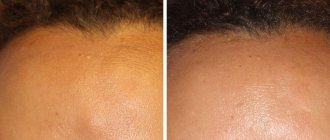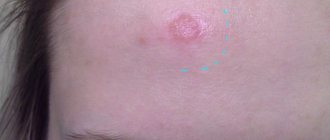Any lump that forms on the surface of the body is a cause for concern, especially if it is located in a visible area or in an area subject to friction and pressure. For example, a ball on the neck under the skin immediately attracts attention; if there is pain, it can significantly reduce the quality of life. In addition, the question arises as to what causes it, how dangerous it is, and whether it can go away on its own.
Sometimes a lump on the neck reaches alarming proportions, but the seriousness of the problem is not at all determined by the size of the lump. There may be several reasons for the formation of this formation, including:
- lipoma;
- atheroma;
- inflammation of the lymph node;
- boil/carbuncle;
- osteochondrosis;
- abscess (suppuration as a result of injury);
- phlegmon;
- malignant tumor.
The most dangerous phenomena, including various purulent formations, are accompanied by all signs of an inflammatory process, are usually painful when touched, and can cause an increase in body temperature. If there is no pain, the surface of the lump does not differ in color from other areas of the skin, or has a whitish tint, then, despite its huge (sometimes) size, the formation may turn out to be a simple wen that does not pose any danger.
Localization and clinical manifestations of lumps on the neck
Depending on the etiology, a lump on the neck can be localized anywhere - back, side, front
Muscle tissue is located mainly at the back and sides. On the side there are also lymph nodes that follow each other. If several lumps are felt at once, inflammation has most likely begun in the lymph nodes.
If the lump on the neck is located at the back, the cause may be:
- wen or lipoma;
- lymphogranulomatosis;
- atheroma;
- furuncle;
- myositis - compaction in muscle tissue.
Also, protrusion is sometimes observed with cervical osteochondrosis.
If a lump appears on the side of your neck, it is possible:
- purulent inflammation;
- lymph nodes have enlarged;
- fibroma, less often lipoma;
- neoplasm of a neurogenic nature;
- allergy.
If the lump is located in the front, the thyroid gland or lymph nodes are most likely enlarged, since there are most of them in the front of the neck.
Some tumors are painless and can move under the skin upon palpation. The pain most often comes from an inflamed lymph node, an abscess or a lump in a muscle. Depending on the origin of the lump, treatment is prescribed.
Size of tumor
Large boil on the neck
Lymph nodes do not grow large: as soon as the inflammation passes, they return to their previous size. A lipoma is not a dangerous tumor, but it can grow into a giant lump, so it is better to remove it so that it does not leave a large scar in a visible place.
Boils also ripen quickly and rupture, followed by the discharge of pus. To prevent re-infection, it is recommended to treat the wound in the hospital and take a course of antibiotics for prevention.
The most dangerous diseases are lymphogranulomatosis and malignant thyroid tumor, as they can give metastases if not detected in time and treated late.
Prevention of tumors under the skin
It is difficult to talk about treating lumps under the skin with such a variety of causes that cause this condition. Self-medication for any type of tumor is not recommended. It is best to take time for your health, get an accurate diagnosis from your doctor and a prescription for the treatment of the detected pathology.
Prevention is another matter! It, of course, will not protect against the appearance of subcutaneous balls in any case, but it can prevent the appearance of some of them. Here's what you can do to protect yourself:
- carefully observe personal hygiene to avoid the development of purulent inflammations;
- procedures that injure the skin - punctures of the nose, ears, tattooing - must be performed only by very good specialists with an excellent reputation;
- If you find even a small ball in yourself, consult a doctor, preventing the disease from spreading by itself;
- Having a genetic predisposition to cancer pathologies, be attentive to your health and undergo an annual examination by a specialist.
These measures will only help in some cases. It is impossible to protect yourself 100% from the appearance of subcutaneous tumors. However, serious illnesses can be avoided if even minor symptoms are not ignored.
Source: skincenter.ru
Possible causes of pathology
In order not to panic in vain before seeing a doctor, it is recommended to understand how certain tumors on the neck behave, what symptoms they cause, how dangerous they are in the future or at the moment.
Lipoma
Wen does not pose a danger, but it interferes from an aesthetic point of view
The cause of lipoma is most often a violation of metabolic processes in the body. This is the most harmless tumor that does not require specific treatment. It is removed for aesthetic reasons, since the ball on the neck under the skin can quickly increase in size.
The fatty tissue is removed urgently if it is located near large arteries and blocks blood flow or partially impairs respiratory function.
A distinctive feature of a lipoma is its painlessness and mobility under the skin.
Atheroma
Atheroma is similar in appearance to lipoma, but its appearance is caused by blockage of the sebaceous gland duct. The lump can fester over time, which poses a health risk. It is most often located at the back, closer to the hair.
As the atheroma grows, it turns into a cyst filled with adipose tissue, epithelial cells, and fluid. The problem is that when it ruptures, purulent contents leak out, but the capsule itself can cause the lump to re-form. It must be removed in a hospital setting and the wound treated with antiseptics.
Fibroma
Fibroma grows slowly, has a round or oval shape with clear outlines
Fibroma is determined by its shape: it is round, regular in shape, dense in consistency, and has clear outlines.
A fibrous tissue tumor grows slowly. In most cases, the predisposition to connective tissue growth is inherited. It very rarely degenerates into a malignant tumor. A fibroma is operated on if it quickly increases in size and causes aesthetic discomfort.
Tumors of neurogenic origin
Neurogenic tumors develop on the nerve process of the parasympathetic trunk. These are cysts that come in different origins:
- neuroma;
- ganglioneuroma;
- neurofibroma.
Tumors of neurogenic origin are painless, most often safe, but there are malignant neoplasms that are removed surgically, then chemotherapy and radiation are prescribed. The closer the tumor is to the spine, the more likely it is that it is a cyst of nervous tissue.
Boils
A boil forms for several reasons:
- poor personal hygiene, clogging of skin pores with dirt, sweat and fat;
- prolonged exposure to drafts or hypothermia.
A boil is manifested by redness of the skin, itching and pain. Then it increases in size, matures and bursts. The danger of furunculosis lies in the possible infection of the blood through the network of capillaries, so self-medication is not recommended.
Enlarged lymph nodes
An enlarged lymph node may be due to a cold or viral infection
Inflammation in the lymph nodes accompanies almost every cold or viral infection, since it is in the lymph nodes that microorganisms are recognized and the toxic load on the body is analyzed.
Inflamed lymph nodes are located on the side of the neck - closer to the ears or under the lower jaw. Sometimes several painful lumps may appear as the nodes are located along the lymphatic vessel in a chain. This phenomenon is especially common in children, since their immune system is poorly developed and reacts more sharply to pathogenic microorganisms.
If an inflamed and enlarged lymph node does not hurt, this may indicate a malignant process - lymphoma or lymphogranulomatosis.
Lymphangioma
Lymphangioma is a benign tumor whose cells grow from the walls of lymphatic vessels. Most often, the tumor is congenital and requires treatment by sclerotherapy, since surgical removal is ineffective.
Cystic lymphangiomas quickly grow to enormous sizes, while others grow slowly.
In adults, benign tumors are the result of a disease of the lymphatic system. They are formed in places where lymphoid tissue accumulates, one of which is the neck area.
Myositis or myogelosis
Myositis develops gradually: first there is pain in the neck, then the mobility of this area is limited. Later, upon palpation, you can feel small lumps, which are very painful. Myositis can be caused by hypothermia, prolonged sitting with a bowed head, or sleeping in an uncomfortable position. Cervical myositis can disrupt the functioning of the larynx and pharynx. The person has difficulty breathing or swallowing.
Myogelosis causes compaction of muscle tissue throughout its entire volume, which impairs blood flow due to compression of the arteries. As a result, a painful lump may appear on the neck, and then the pain will spread to the shoulders, arms, and spine. Severe headaches are possible.
Lump after injury
A lump on the neck may appear due to injury. Such bruises are especially dangerous, since large arteries supplying blood to the brain, as well as lymphatic vessels and nodes, are located nearby. When struck, lymph fluid leaks out, forming a swelling. The swelling may last for several days. Possible internal bleeding or arterial thrombosis.
If a person has received a blow to the neck area, he needs urgent medical assistance to relieve swelling and check the integrity of blood vessels.
Osteochondrosis
Osteochondrosis is a degenerative disease of the spine associated with a sedentary lifestyle and destruction of the intervertebral disc. The diagnosis can be confirmed even in young people who are overweight and have flabby muscles surrounding the spine. The cervical region is the most mobile, so the risk of developing osteochondrosis is higher in the neck area.
Sometimes, when the vertebrae rub against each other and bone tissue grows, osteophytes are formed. The largest of them can protrude above the surface of the skin. Osteophytes are an advanced stage of the disease. With cervical osteochondrosis, the brain suffers because blood flow in the vertebral artery passing through the neck area is disrupted.
Thyroid diseases
Tumor in the front of the neck due to an enlarged thyroid gland
A lump in the front of the neck may indicate a problem with the thyroid gland. Diffuse goiter is an increase in the size of the entire gland evenly. Nodal involves the presence of several dense areas.
The most common benign tumors of the thyroid gland are caused by a lack of iodine in the diet. By increasing its amount through a special diet or taking iodine-containing medications, it is possible to eliminate seals. Sometimes, in advanced stages, it is necessary to resort to surgical removal of the nodes.
A painless, hard lump or tumor is a cause for concern, as it most often indicates cancer.
Pathological symptoms
It can be difficult to understand what kind of lump has appeared on the body; sometimes only a surgeon or oncologist can figure it out. Often a number of diagnostic procedures are required, and they are carried out after the operation.
But a person can independently suspect a pathology by paying attention to a number of characteristics of the compaction.
So read pathology:
- When the formation rapidly increases in size, you should consult a doctor for advice. Some types of oncology have similar properties. Atypical cells rapidly develop, resulting in tumor growth.
- If a small infiltrate under the skin periodically becomes inflamed or painful, then a doctor’s consultation is necessary.
- A moving ball, the appearance of which is accompanied by signs of intoxication of the body, should also be regarded as a pathology. This phenomenon is troubling with a progressive inflammatory process in tissues.
- When the infiltrate suddenly appears under the skin, it grows rapidly, and the person’s condition worsens against this background - it is worth undergoing a comprehensive examination.
Mobility is not considered a pathological sign, unlike pain. Pain is perceived as a signal that the body gives when certain problems do not occur.
If a boy or girl notices a lump on the skin that is shaped like a dense ball, you should show the child to a doctor.
Similar symptoms are observed in leukemia and oncology of the lymphatic system. Examination by an oncologist and blood tests will help rule out the possibility of cancer.
Diagnosis of seals on the neck
Thyroid nodule on ultrasound
When visiting a doctor, the patient will be recommended to undergo several types of diagnostics. First of all, this is a urine and blood test for an inflammatory process - acute or latent. This is a common procedure for all patients. If there is a purulent process (furunculosis), the analysis will determine the type of pathogen in order to correctly select antibiotics and auxiliary drugs.
If the lump on the neck is a benign tumor, it is first examined by ultrasound. If a malignant process is suspected, an MRI is prescribed, thanks to which layer-by-layer sections of soft tissue are obtained. If the oncological process is confirmed, the doctor prescribes a histological examination of the cells, for which a piece of tissue is taken and examined under a microscope. This allows you to determine the type of tumor, its tendency to metastasize and rapid growth.
For diseases of the thyroid gland, blood is drawn to determine the amount of hormones, as well as tissue diagnostics using ultrasound.
X-rays are done for myositis or myogelosis. It is advisable to perform angiography of the neck vessels to determine the speed and volume of blood flow in the vertebral artery.
Treatment and removal: methods
The formation is removed surgically, but various options are possible. In addition to the usual scalpel, the surgeon can eliminate the contents of the tumor with the help of a schiritsa by pumping it out.
This technique is used for cysts, as well as if the formation is filled with purulent contents.
If the tumor is dense in structure and contains pus, then an autopsy is performed in the standard way. Then the area is cleaned, and drainage can be installed.
Oncological tumors require long-term treatment; in addition to surgery, chemotherapy or radiation therapy is performed.
If leukemia is confirmed, a bone marrow transplant is required.
Everything largely depends on the specifics of the tumor and its location. The doctor pays attention to which parts are involved in the process, whether the walls of blood vessels and healthy tissues are affected.
A papilloma or wart can be removed with a laser, but this cannot be done with a formation from connective or adipose tissue.
Recommendations
- If you find a lump on your neck, remember whether you have been injured, prepare competent and detailed answers to the doctor’s questions and come to see him as soon as possible.
- Do not neglect the directions that the specialist will prescribe for you.
- Strictly follow your doctor's recommendations after the examination.
- Do not self-medicate and under no circumstances heat the seal!
A seal in such a vulnerable place as the neck is no joke. Even if it does not bother you or hurt you, consult with an experienced specialist. This pathology requires an urgent response and an individual approach. After all, sometimes even cancer can be treated, but only in the early stages.
Child's health
If you notice a swelling in your child's neck, it is most likely due to injury. Try to remember if your baby has fallen recently. Or maybe he hit something hard?
If this is the case, the baby may experience dizziness, nausea, and blue discoloration of the injured area. Possible concussion. The little patient needs to be urgently taken to the hospital. Before that, you can try to reduce the pain by applying a cold leaf of cabbage or other product. Apart from these actions, nothing else needs to be done!
Another reason for the formation of a lump in a child is inflammation of the lymph nodes. Children have weak, unformed immunity, so this phenomenon is not uncommon for them. But neoplasms do not often occur at an early age. Much less common than in adults. But they shouldn’t be excluded either.
Lump formation in cervical osteochondrosis
A noticeable hump formed in the area of the cervical spine may indicate that a person has osteochondrosis. Cervical osteochondrosis is a very common disease that is diagnosed even in very young people. Osteochondrosis of the cervical spine occurs for many reasons, including:
- sedentary work, in which a person is forced to stay with his head down for a long time (for example, office employees or programmers);
- spinal injuries;
- incorrect posture;
- scoliosis;
- lack of sufficient physical activity.
The appearance of a hump on the neck is not the only sign of the disease. Cervical osteochondrosis causes a lot of other unpleasant symptoms in patients, including:
- dizziness;
- pain in the head and shoulders;
- crunch in the neck when turning;
- pain and numbness in the hands;
- pain in the chest area;
- fast fatiguability.
The listed signs of the disease tend to intensify during physical activity. This causes serious discomfort to the patient. Having noticed symptoms indicating cervical osteochondrosis, the patient needs to seek help from a neurologist or chiropractor.
If osteochondrosis of the cervical spine is not treated, then over time the disease will begin to progress, and the hump will become even larger.
For osteochondrosis, complex treatment is used, including:
- prescription of medications intended for internal and external use (tablets, ointments, gels);
- physiotherapy (myostimulation, electrophoresis, etc.);
- professional massage;
- daily therapeutic exercises (you can use exercises for the spine according to the Norbekov system);
- playing sports (swimming is very useful for people diagnosed with cervical osteochondrosis).
A person with osteochondrosis needs to pay attention to his bed: the mattress on which he sleeps should be moderately hard. If you follow all the doctor’s recommendations, the patient will feel better in 1-2 weeks, and the lump will begin to shrink and gradually disappear completely. In order for cervical osteochondrosis to no longer bother a person, he needs to regularly do morning exercises, take daily walks in the fresh air, play sports or yoga.










